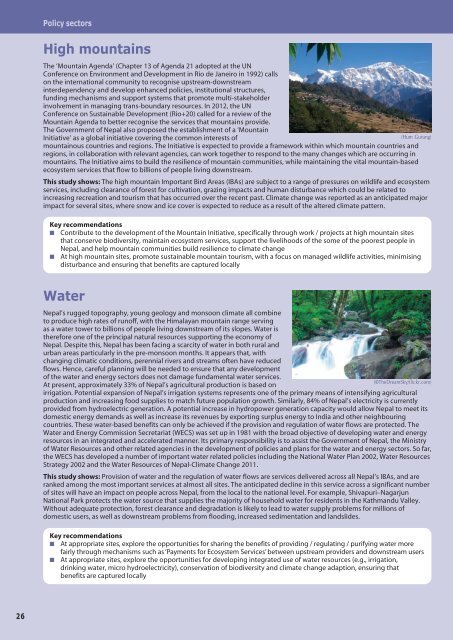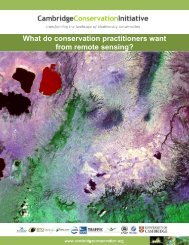CONSERVING BIODIVERSITY & DELIVERING ECOSYSTEM SERVICES
conserving biodiversity & delivering ecosystem services
conserving biodiversity & delivering ecosystem services
Create successful ePaper yourself
Turn your PDF publications into a flip-book with our unique Google optimized e-Paper software.
The ‘Mountain Agenda’ (Chapter 13 of Agenda 21 adopted at the UN<br />
Conference on Environment and Development in Rio de Janeiro in 1992) calls<br />
on the international community to recognise upstream-downstream<br />
interdependency and develop enhanced policies, institutional structures,<br />
funding mechanisms and support systems that promote multi-stakeholder<br />
involvement in managing trans-boundary resources. In 2012, the UN<br />
Conference on Sustainable Development (Rio+20) called for a review of the<br />
Mountain Agenda to better recognise the services that mountains provide.<br />
The Government of Nepal also proposed the establishment of a ‘Mountain<br />
Initiative’ as a global initiative covering the common interests of<br />
(Hum Gurung)<br />
mountainous countries and regions. The Initiative is expected to provide a framework within which mountain countries and<br />
regions, in collaboration with relevant agencies, can work together to respond to the many changes which are occurring in<br />
mountains. The Initiative aims to build the resilience of mountain communities, while maintaining the vital mountain-based<br />
ecosystem services that flow to billions of people living downstream.<br />
This study shows: The high mountain Important Bird Areas (IBAs) are subject to a range of pressures on wildlife and ecosystem<br />
services, including clearance of forest for cultivation, grazing impacts and human disturbance which could be related to<br />
increasing recreation and tourism that has occurred over the recent past. Climate change was reported as an anticipated major<br />
impact for several sites, where snow and ice cover is expected to reduce as a result of the altered climate pattern.<br />
Key recommendations<br />
■ Contribute to the development of the Mountain Initiative, specifically through work / projects at high mountain sites<br />
that conserve biodiversity, maintain ecosystem services, support the livelihoods of the some of the poorest people in<br />
Nepal, and help mountain communities build resilience to climate change<br />
■ At high mountain sites, promote sustainable mountain tourism, with a focus on managed wildlife activities, minimising<br />
disturbance and ensuring that benefits are captured locally<br />
<br />
Nepal’s rugged topography, young geology and monsoon climate all combine<br />
to produce high rates of runoff, with the Himalayan mountain range serving<br />
as a water tower to billions of people living downstream of its slopes. Water is<br />
therefore one of the principal natural resources supporting the economy of<br />
Nepal. Despite this, Nepal has been facing a scarcity of water in both rural and<br />
urban areas particularly in the pre-monsoon months. It appears that, with<br />
changing climatic conditions, perennial rivers and streams often have reduced<br />
flows. Hence, careful planning will be needed to ensure that any development<br />
of the water and energy sectors does not damage fundamental water services.<br />
(©TheDreamSky/flickr.com)<br />
At present, approximately 33% of Nepal’s agricultural production is based on<br />
irrigation. Potential expansion of Nepal’s irrigation systems represents one of the primary means of intensifying agricultural<br />
production and increasing food supplies to match future population growth. Similarly, 84% of Nepal’s electricity is currently<br />
provided from hydroelectric generation. A potential increase in hydropower generation capacity would allow Nepal to meet its<br />
domestic energy demands as well as increase its revenues by exporting surplus energy to India and other neighbouring<br />
countries. These water-based benefits can only be achieved if the provision and regulation of water flows are protected. The<br />
Water and Energy Commission Secretariat (WECS) was set up in 1981 with the broad objective of developing water and energy<br />
resources in an integrated and accelerated manner. Its primary responsibility is to assist the Government of Nepal, the Ministry<br />
of Water Resources and other related agencies in the development of policies and plans for the water and energy sectors. So far,<br />
the WECS has developed a number of important water related policies including the National Water Plan 2002, Water Resources<br />
Strategy 2002 and the Water Resources of Nepal-Climate Change 2011.<br />
This study shows: Provision of water and the regulation of water flows are services delivered across all Nepal’s IBAs, and are<br />
ranked among the most important services at almost all sites. The anticipated decline in this service across a significant number<br />
of sites will have an impact on people across Nepal, from the local to the national level. For example, Shivapuri–Nagarjun<br />
National Park protects the water source that supplies the majority of household water for residents in the Kathmandu Valley.<br />
Without adequate protection, forest clearance and degradation is likely to lead to water supply problems for millions of<br />
domestic users, as well as downstream problems from flooding, increased sedimentation and landslides.<br />
Key recommendations<br />
■ At appropriate sites, explore the opportunities for sharing the benefits of providing / regulating / purifying water more<br />
fairly through mechanisms such as ‘Payments for Ecosystem Services’ between upstream providers and downstream users<br />
■ At appropriate sites, explore the opportunities for developing integrated use of water resources (e.g., irrigation,<br />
drinking water, micro hydroelectricity), conservation of biodiversity and climate change adaption, ensuring that<br />
benefits are captured locally




